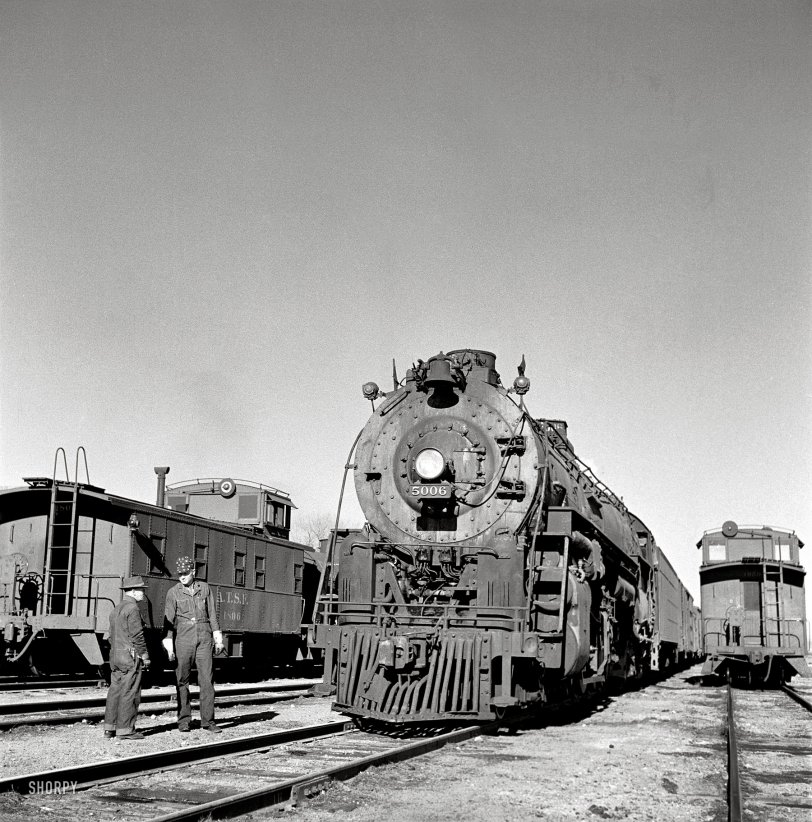


Framed or unframed, desk size to sofa size, printed by us in Arizona and Alabama since 2007. Explore now.
Shorpy is funded by you. Patreon contributors get an ad-free experience.
Learn more.

- Tough Guys
- Lost in Toyland
- And without gloves
- If I were a blindfolded time traveler
- Smoke Consumer Also Cooks
- Oh that stove!
- Possibly still there?
- What?!?
- $100 Reward
- Freeze Frame
- Texas Flyer wanted
- Just a Year Too Soon
- WWII -- Replacing men with women at the railroad crossing.
- Yes, Icing
- You kids drive me nuts!
- NOT An Easy Job
- I wonder
- Just add window boxes
- Icing Platform?
- Indiana Harbor Belt abides
- Freezing haze
- Corrections (for those who care)
- C&NW at Nelson
- Fallen Flags
- A dangerous job made worse
- Water Stop
- Passenger trains have right of way over freights?
- Coal
- Never ceases to amaze me.
- Still chuggin' (in model form)
Print Emporium
Santa Fe: 1943

March 1943. Vaughn, New Mexico. "Eastbound train about to leave the Atchison, Topeka and Santa Fe yard on the return trip." Medium-format nitrate negative by Jack Delano for the Office of War Information. View full size.
That thing on the caboose
In the days before radio-equipped trains, the Santa Fe used "wigwags" on its waycars (Santa Fe parlence for a caboose) to let the conductor signal a "highball" to the engine crew. A neat aspect about this photo is that it shows the early (left waycar) and the late (right waycar) wigwag designs. More about wigwags here.
Signal disks on caboose cupolas
The round disks on the cupola were used to signal the engineer. Here's the details:
Caps
The Kromer Cap! I never knew the name of those. Thanks Casey and Gazzie.
No Thanks, Mr. Kromer
The Kromer cap has nothing on the old denim octagon cap, which came in blue, white, black, or pinstripes. Truly the overwhelming favorite of America's railroaders.
Why a polka dot cap?
Same reason that covers most male garments of the polka dot variety. You are secure in knowing no one will ever steal it or mistake it for their own. Exception being jockey gear.
On the caboose
I'm guessing that thing is a semaphore for signaling the engineer.
Re: Polka Dots
I've never read about them being standard issue. Maybe the man was a welder? Modern day welding hats come in polka dots and other loud patterns. My guess is that they were originally made at home from scrap cloth by the workers' wives.
Is there anything left of the Vaughn Railroad Yard? I was there in the mid-90's and saw some old rolling stock and what may have been dormitory cars for a work train. Went back in '04 and didn't see anything in the way of a yard, but didn't have much time to look around.
When Vaughn was still a Crew Change
In steam days Vaughn, New Mexico was a crew change point. Today's BNSF trains sail right thru between Clovis on the east and Belen to the west. The target-like devices on the caboose cupolas were raised up as markers during unscheduled stops, so as to protect the rear of the train.
Polka Dot Cap
My dad worked for the B&O Railroad in Cumberland Maryland in the 1950's and he always wore those polka dot caps. His was dark blue with white dots. It's a Kromer Cap and you can still get them here.
Here's the story....
In Kaukauna, Wisconsin, at the turn of the century, George Kromer, an engineer for the Chicago and Northwestern Railroad, decided that there was not available a single cap of quality materials and manufacture which suited the needs of railroad men. So he made one.
Kromer drew up the design and specifications. His wife, Ida, did the cutting and sewing. The cap had to be one-hundred percent cloth with a soft flexible visor. It had to cling to the head despite strong gusts of wind that plagued rail hands everywhere. Ida Kromer added her own touches., a sweatband of absorbent cloth and an outside band which could be pulled down over the ears. The Kromer cap was born.
Over 1000 reads
and no one said it, so I will.
Trains are so cool!
Polka Dots and Rail Beams
Yeah I know bad pun, stretched too far. Anyway, what's with the polka-dotted hats? Was it for greater visibility of the yard workers from the engineer's compartment?
























On Shorpy:
Today’s Top 5